► All-electric Supervan takes on famed Pikes Peak hillclimb
► Supervan 4.2 aims to challenge record-holders
► Can it do it? Watch here…
On the 101st running of the world’s toughest hillclimb, one vehicle stood out from the rest of the pack. Pikes Peak saw Ford bring along its incredible Supervan 4.2, an all-electric van aiming to challenge the course record.
Ford’s produced (somewhat over-produced) an 18-minute video charting the team’s attempt. It’s got it all – ace cinematography, interviews with slightly churlish Garys from Ford Performance, bonus Max Verstappen, and an overdramatic narrator.
Taking on one of the world’s most challenging motorsport events in what looks more like an E-Transit than a racer is no small feat; it’s a good thing the Supervan is no normal Transit.
We first saw the high-velocity electric van at the 2022 Goodwood Festival of Speed, underlining this EV’s promotional purpose. It’s very much a strategic tool to underline Ford’s rapid transformation into a purveyor of electric vehicles – for passengers and cargo.
Ford has form at Pikes Peak: a Model T won the very first race in 1916, lumbering 12.4 miles through 156 turns on the steep ascent of Pikes Peak in a time of 28min 3sec. Ace rent-a-race-driver Romain Dumas piloted the SuperVan 4.2 at the 2023 race, aiming to win the Open class as well as challenge the overall record. Did he manage it? Watch the video to find out…
There have been a series of improvements made to the SuperVan since it was first shown at Goodwood, sufficient to warrant an upgrade in name – this is now officially the SuperVan 4.2. These are centred around optimising it for tackling the Pikes Peak gradient, with aerodynamic changes designed to deal with the high-altitude air and improve downforce. It’s also shed power as a result of this, losing 600hp in the process.
Ford electric cars: what you need to know
What can the latest Ford SuperVan do?
The Pikes Peak improvements focus on two major areas – the powertrain and the aerodynamics. Where the original Ford Pro Electric SuperVan, to give it its full name, was powered by four motors, the 4.2 has cut this down to three in a bid to improve the power-to-weight ratio.
This has seen a reduction in power from the original 2000hp, although the latest version still offers a not-insignificant 1400hp. One of the motors powers the front wheels and two sit at the rear of the vehicle.
There is still no talk of an official 0-62mph time, but the original was talking about something in the region of less than two seconds.
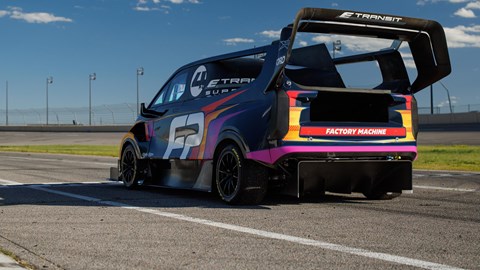
Funnily enough, the engineers haven’t gone into much detail on the range, either, but it has said the SuperVan can be recharged to full in just 45 minutes on a standard fast charger.
What else is special about the SuperVan 4.2?
The Pikes Peak version of the SuperVan was reworked by Ford Performance and experts at STARD Advanced Research and Development. As the event ends up 14,115ft above sea level, the van needed to be able to deal with the thinner air at the finish line. The tweaks include a new lightweight carbon-fibre rear spoiler and front splitter. The removal of one of the motors has also helped it shed weight, resulting in 1996kg of downforce at 150mph.
The brake regeneration system has also been revised, as have the driveshafts, while it is fitted with magnesium-forged wheels with Pirelli P Zero racing tyres. The weight-saving sees it get a Perspex windscreen while everything unnecessary has been stripped out from the interior.
That time we hitched a ride in an XJ220-powered Transit
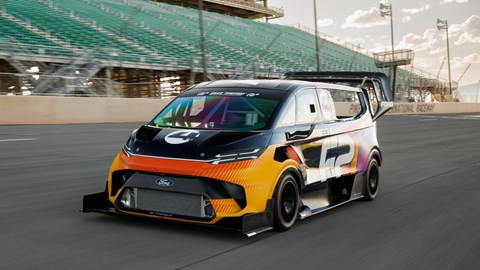
The original had a selection of driving modes, which allow the driver to tailor the van for different uses. These include Road, Track, Drag, which enhances straight-line acceleration, Drift for sideways showoffs and Rally for heading out on low-friction surfaces.
If that wasn’t enough then there’s also launch control, pit-lane speed limiter and an E-Boost function. We expect Dumas will be fettling all these settings to prepare it for the 1440m thash up Pikes Peak.
Perhaps the most ridiculous feature is the Supervan’s Tyre Cleaning Mode that brakes one axle and allows you to send a load of that power to the other to scrub off some rubber and warm what remains. It works on both front and rear axles, too.
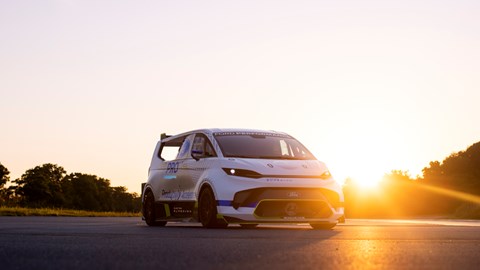
There are a few energy-saving features too, including three-stage brake regeneration and an Eco mode. For those moments when you need to pop down the shops and want to save battery perhaps.
Standard software
One thing that was carried over from Ford’s more conventional vehicles is the infotainment, which is the latest Sync system, as seen in models such as the Mustang Mach-E. This allows Ford to plot a route, find a charger, send data for analysis and get insights on the charging and battery. The big vertical screen has been a casualty of the weight-saving regime, though, with the cabin now much barer and more basic.
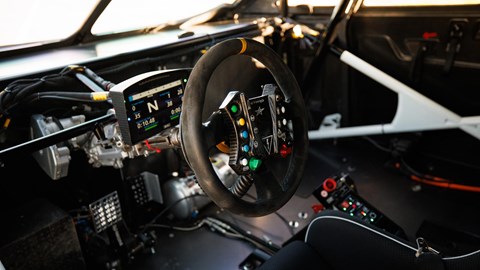
Road and hillclimb ready
The SuperVan is rumoured to be road legal, even if you might baulk at taking on any sort of speed bump or width restriction with those wheelarches and front splitter, but it’s arguably more suited to the hillclimbs of Goodwood and Pikes Peak. Dumas has already demonstrated the van at the Festival of Speed and set electric records at the Nurburgring, so it’ll be in with a good shout in Colorado.
What’s a SuperVan?
There have been three previous SuperVans, and, like this one, they have all been bonkers explorations of what can be done when you put a very fast engine under the most sensible and practical vehicle that Ford makes – the Transit. The first one appeared in 1971 and took a GT40 chassis and popped a van bodyshell on the top. For good measure, it then added a 4.0-litre V8 into the mix.
The second generation came in 1984 and took a C100 Group C chassis and put a 590hp Cosworth racing engine underneath.
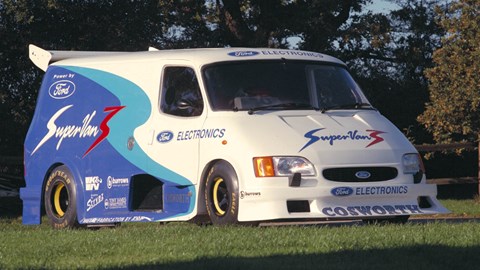
This then evolved to the SuperVan 3 in 1994 (pictured above), which used the same chassis and a 650hp 3.0-litre supercharged V6 Cosworth engine of the type seen in F1 cars of the time. This was good for 150mph and it wasn’t afraid to do it either.